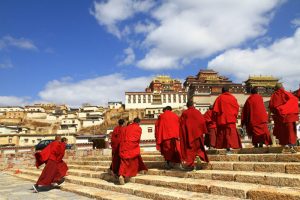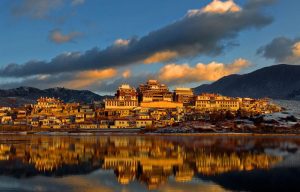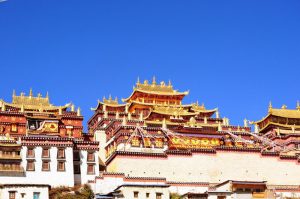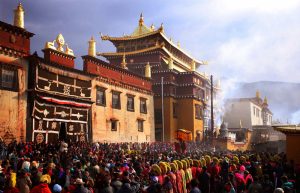
Songzanlin Monastery in Shangri-la
Attraction Overview
Built in 1679, the monastery is the largest Tibetan Buddhist temple complex in Yunnan province and one of the famous monasteries in the Kang region, which belongs to the Yellow Hat sect of Tibetan Buddhism of the Gelukpa order of the Dalai Lama. It is reputed as the Little Potala Palace due to its complex of Potala Palace in Lhasa, Tibet.
Attraction Type: Tibetan Buddhist Temples
Chinese Name: 松赞林寺(Pinyin: Sōngzànlín Sì)
Best Time to Visit: From March to May and September to November
Recommended Visiting Time: 2 Hours
Open Hours: 08:00 - 18: 00
Admission Fee: CNY 90(including Tour Bus and Guide Fee)
Altitude: 3200 m
Location: at the foot of Fopingshan Mountain, about 5 kilometers or 3.1 miles north of Shangri-La
Why is Songzanlin Monastery So Special?
Built in 1679, the monastery is the largest Tibetan Buddhist temple complex in Yunnan province and one of the famous monasteries in the Kang region, which belongs to the Yellow Hat sect of Tibetan Buddhism of the Gelukpa order of the Dalai Lama. It is reputed as the Little Potala Palace due to its complex of Potala Palace in Lhasa, Tibet. Located in the capital of Diqing Tibetan Autonomous Prefecture, it is also the most important monastery in southwest China.
Where is Songzanlin Monastery – Location
The Ganden Sumtsenling Monastery, also known as Sungtseling and Guihuasi, is situated 5 kilometres from the city of Shangrila at elevation 3,380 metres (11,090 ft) in Yunnan province, China. The specific location is at the foot of Fopingshan Mountain (佛屏山), Shangrila City.
Distance from other attractions in Shangri-La
About 5.6 km from Duzekong Old Town and Guishan Hill
About 26.2 km from Pudacuo National Park
About 85.6 km from Tiger Leaping Gorge
History and Culture
Construction of the monastery began in 1679 and was completed in 1681. The Fifth Dalai Lama decided the location though divination and gave the name—Gedansongzanlin (噶丹松赞林). “Ganden” has relationship with Ganden Monastery in Tibet which was built by Tsongkhapa of Gelug Sect. It was built during the rule of the Qing dynasty Kangxi Emperor. He fully patronized the development of this monastery. It is also said that the emperor was associated in the reincarnation search for the Seventh Dalai Lama.
In the 1930s, the monastery had provided full support to the Communist general He Long who passed through this area during his campaign. It was extensively damaged in the Cultural Revolution and subsequently rebuilt in 1983; at its peak, the monastery contained accommodation for 2,000 monks; it currently accommodates in its rebuilt structures 700 monks in 200 associated houses.
The monastery is full of treasures. There are a lot of golden figures of Buddha josses, golden lamps, Tibetan lections, silver censers and so on. All of these are wonderful collections accumulated from each dynasty.

Architecture
The architecture of Songzanlin Monastery is a fusion of the Tibetan and Han Chinese. The monastery has two major lamasery buildings – Zhacang and Jikang – apart from several smaller lamaseries. The main monastery structure built in Tibetan style has a gilded copper roof similar to the one at the Potala Monastery in Lhasa. The other buildings in the complex are built in Han Chinese style.
It has six main structures including eight colleges. The entrance gate is at the foot of the hill and provides access to the main hall of the monastery through 146 steps. In the main hall of the monastery, more than 1500 monks congregate to recite the Buddhist scriptures. This hall houses a plethora of scriptures written on palm leaves, a gilded statue of Shakyamuni Buddha which is 8 metres (26 ft) tall at the main altar along with paintings depicting the life of Buddha. The altar has permanent decorated by yak butter lamps.
How to Get to Songzanlin Monastery?
By Bus
There are autobuses in Shangri-la City which can take you to Songzanlin Monastery directly, and the buses No.3 at the front of Moonlight Square can also take you there without stop.
By Minivan
Many minivans are available at Moonlight Square that travelers can hire to go there. You need to discuss the price with the drivers before you get on the van.
By Biking or Walking
Tourists can get to Songzanlin Monastery by biking or by walking, individually taking about 20 minutes and 1 hour.

Main Attractions
►Main Scripture Hall
In the main hall of the monastery, more than 1500 monks congregate to recite the Buddhist scriptures. This hall houses a plethora of scriptures written on palm leaves, a gilded statue of Shakyamuni Buddha which is 8 metres (26 ft) tall at the main altar along with paintings depicting the life of Buddha. The altar has permanent decorated by yak butter lamps.
►Dratsang Basilica
Covering an area of 1500 square meters and 39.6 meters tall, it is one of the earliest constructions in Songzanlin Monastery built in 1697 A.D, 18th year in Emperor Kangxi period in Qing dynasty, the period when the 5th genealogy of Dalai was reigned. Dratsang Basilica is the place for monks chanting together in Songzanlin Monastery. And inside the Dratsang Basilica, there are enshrined the 5th genealogy of Dalai Lama Jwasang, Zongkeba Buddha, Jamba Buddha, Sakyamuni Buddha, the 3rd genealogy of Dalai, the 7th genealogy of Dalai, the 10th genealogy of Panchen Jwasang.
►Sakyamuni Basilica
Built in 1697 A.D, 18th year in Emperor Kangxi period in Qing dynasty and covering an area of 556 square meters, it is also known as Wenshu Buddha Basilica. Inside there are enshrined Wenshu Buddha with the height of 13.58 m, and Sakyamuni Buddha with pictures described his life around him.

►Zha Laju Religious Rituals Magic Basilica
Being one of the earliest constructions in Songzanlin Monastery and covering an area 159 square meters, it was also built in 18th year in Emperor Kangxi period in Qing dynasty. Inside, it enshrined custodian of immortals.
►Zong Keba Basilica
Built in 1697A.D and covering an area of 789 square meters, it is 36 m high with 4 exceedingly high posts known as Gold Tile Temple for the flammule-flashing gold tile which could be seen a few miles away. Inside, there is enshrined The First Buddha in Tibetan Areas ZongKeBa master Jwasang with the height of 18 m.
►Lamuyangcuo Lake
Located in front of the Songzanlin Monastery, it is a holy lake dwelled by the soul of Goddess Bandanlamu, a guardian goddess of universe. Lamuyangcuo, means the Soul of Heaven Fairy Lake. The celestial burial platform is standing in its south. In every important Buddhist ritual or the occasion of making major decisions, the monks and believers led by the Rinpoche chant sutras and pray around the lake.

Best Time to Go
From March to May and September to November is the best time to visit Songzanlin Monastery when the scenery of Shangri-la is beautiful. From June to September is the rainy season of Shangrila and winter is very cold with snow. So take enough clothes to keep warm if you visit it in the winter times. During every Dec.26 to Dec.29 by Tibetan calendar, the grand Gedong Festival is held to worship and also to witness the religious mask dances – the Cham dance, which is a rare chance in Shangrila to experience the Tibetan Buddhism culture and religion.
Nearby Attractions
Pudacuo National Park in Shangri-la, Diqing
Being one of the most bio-diverse regions in China’s Yunnan Province, Pudacuo National Park is the first national park in Chinese mainland which was announced on June 25, 2007. With its crystal-clear lakes, undulating mountains and gurgling streams, Pudacuo National Park is definitely a wonderful natural wonderland. Among China’s 2,500 nature reserves, Pudacuo is the only one meets the standards for national parks established by The World Conservation Union. In addition to its rare vegetation and mammal species, the stunning natural beauty of landscape is unmissable for visitors as well.
As one of the largest and best-preserved Tibetan residence groups in China, the 1300-year-old Dukezong Ancient Town, situated at Shangri-la County, Deqing Tibetan Autonomous Prefecture, not only plays an important role in the Old Tea – Horse Road, but also serves as a corridor connecting Chinese and Tibetan language, people, religion and cultures. Until the fire disaster damaged the most of Tibetan dwellings in 2014, it still remains the traditional Tibetan architectural style.
Recommended Visiting Route
The whole time of visiting Songzanlin Monastery is about 2 hours. The entrance gate is at the foot of the hill and provides access to the main hall of the monastery through 146 steps. Tourists should pay attention to visit by clockwise. Besides, the Lamuyangcuo Lake is also a good spot to explore more Tibetan Buddhist culture which needs another 2 hours. Take it into consideration if you have enough time.
Useful Travel Tips
►Due to dry climate and strong ultraviolet radiation, sunscreen, sun hat and sunglasses are needed. If you visit there after October, bring enough clothes for keeping out the cold.
►Dress modestly and behave with good manner. Please visit by clockwise and take off your hat and sunglasses when you entering the hall. Do not point the Buddhas with finger.
► The best location to shoot the panoramic view of Songzanlin Monastery is CongGulong Village Viewing Deck which is located on the road to Lamuyangcuo Lake.
Tours including Songzanlin Monastery
7 Days Shangrila Students Education Course
8 Days Yunnan Classic Tour by High Speed Bullet Train
15 Days Yunnan-Tibet Mount Everest Tours from Kunming to Lhasa by Flight












